How to Optimize Your Landing Page Copywriting
10 min read
If design is the body of the landing page, copywriting is its lifeblood.
Yet, when asked, how many of you could quantify exactly which bits of copy are resonating and which bits are boring or turning off your audience?
Not only that, but how do you gauge the impact of your messaging in a crowded space, where it’s likely a visitor isn’t just looking at your landing page?
For years, landing page builders, CRMs, and email marketing tools have all gotten us accustomed to prioritizing parameters like page layout and structure, as well as copywriting grammar, spelling, and length.
While there’s no denying that such considerations are essential in creating highly-converting copy, the fact of the matter is, we’ve now gotten to the point of saturation.
Take a look at the landing pages across your industry. It’s likely they all, to a certain extent, resemble each other in messaging.
At the moment, high-converting landing pages are the select few that have found a way of tactfully using refined messages to define their strategic advantage.
To optimize your landing page copywriting, you first need to find out what resonates best with your audience and what doesn’t.
The Performance Marketing Paradox: Why Diagnosing Copy Problems is Still Difficult
Landing pages are to performance marketing like food scales are to bodybuilders.
A crucial tool, but in the case of food scales, we have a lot more granularity in our data.
Sure, you can calculate tons of metrics – CAC, LTV, ROAS, and conversion rate.
These direct response metrics give you fast feedback on what’s working and what’s not. But this is at a page and campaign level.
What about at a copy level? Why do traditional metrics fall short when analyzing granular details of the page?
I’m a huge fan of A/B testing. I’ve built my career on it.
However, when it comes to landing page optimization, there are three challenges with controlled experiments:
- First, you likely don’t have enough traffic to run trustworthy controlled experiments (at least on all pages).
- Second, A/B testing quantifies the data between your control and variant, but it doesn’t identify problems or opportunity areas.
- Third, A/B testing gives you aggregate differences in user behavior on a page basis. It doesn’t give you insights on individual sections of copy and how they resonate.
I’m also a huge fan of digital analytics. I spend the majority of my time in Google Analytics nowadays.
But like A/B testing, digital analytics draws inferences from past data and typically aggregates data.
You get to track where your visitors are coming from, what they are viewing, how they are engaging with the page, how much time they are spending on your landing page, plus the corresponding conversion and bounce rates.
When properly orchestrated, this can help you identify over and underperforming landing pages, as well as the engagement and dropoff levels of individual elements.
When you set up proper event tracking, you can even get data on scroll depth and engagement with particular elements on a page:
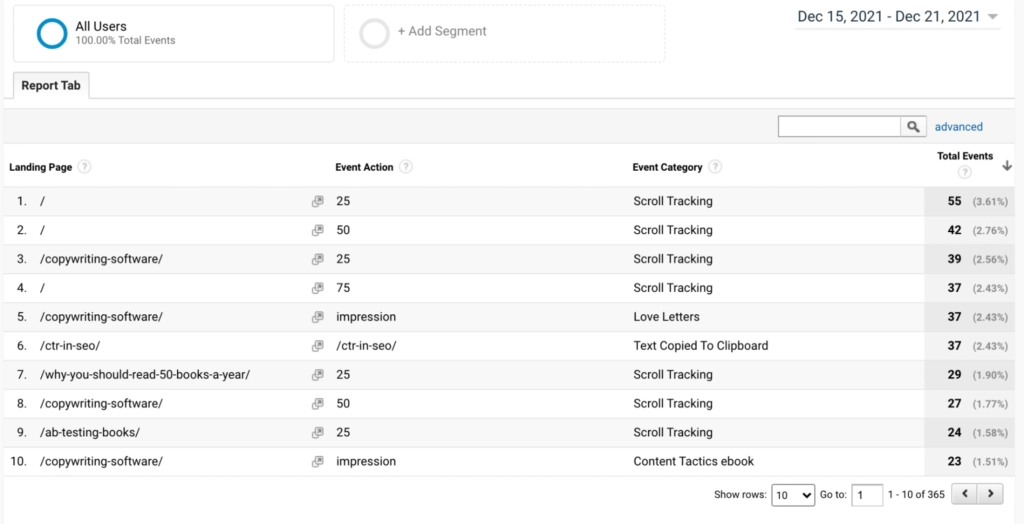
Unfortunately, none of them reveals what your audience likes and dislikes about your landing page copy.
It can’t tell you the “why” or generate hypotheses to fix bottlenecks. Although digital analytics will point out the best-performing landing pages, it doesn’t provide insights into the messages that resonate and those that don’t.
Such a deep level of copywriting specificity can only be uncovered through strategic message testing.
Message Testing: A Method of Quantifying, Diagnosing, and Improving Landing Page Copy
Let’s explore message testing and how it can improve your landing page copy.
What is Message Testing?
Message testing is the whole process of systematically reviewing your messaging, how it resonates, where it falls short, and how to fix it.
The objective here is to determine the efficacy of your copy, measured on a few dimensions such as motivation, clarity, distraction, relevance, and anxiety, to drive the highest conversion rate.
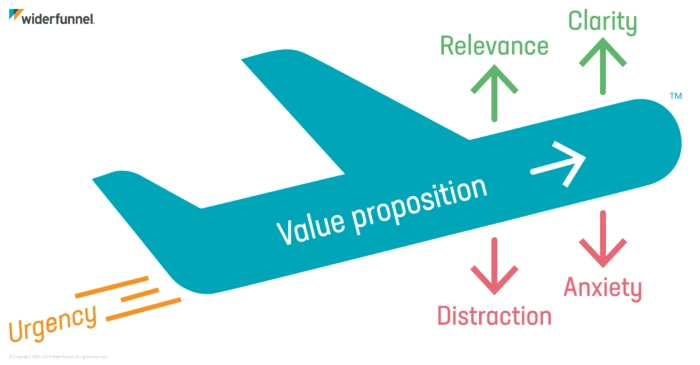
Message testing combines quantitative and qualitative research for increased precision. Typically, the quantitative data will tell you What and Where your problems are, and qualitative data will typically help inform you Why your copy is failing and what to do about it.
Good news: there are great tools nowadays to help you collect the quant and the qual.
These aren’t your grandfather’s focus groups. Now we’ve got AI-based copywriting tools like Jasper to help you rewrite sections of your copy, session replays that automatically flag signs of user frustration, and target audience panels that take less than a day to deliver pages and pages of insights.
Unsurprisingly, there’s an entire SaaS stack available for you now to diagnose and repair your messaging.
It’s a good time to be a conversion optimizer.
The last bastion of gut-based decision-making – copywriting – now falls to the sword of data-driven methodologies. Let me tell you about a few of my favorites.
4 Best Message Testing Methodologies
Now that message testing involves both qualitative and quantitative assessments, you can expect the tool options to be quite diverse.
But, to keep it all simple and relatable, we’ll only review the four primary categories of message testing tools
- User testing tools
- Message clarity testing tools
- Heatmap tools
- Online poll tools
1. User Testing Tools – Wynter, UserTesting
User testing is my go-to methodology for any type of conversion research.
Basically, you get users to navigate and attempt to accomplish goals on your website. This can help you uncover user experience bottlenecks, and now, there are specific tools that help you uncover copywriting bottlenecks.
My tools of choice here are Wynter and UserTesting.
The latter is a human insight platform that conducts analytics for not only marketing, but also software design, and product development. You recruit panels of average users (not your target market), assign them tasks, and watch how they interact with your website in the process.
Wynter is probably even more pertinent to our copy-testing use case. It’s a B2B intelligence tool that helps users figure out what their target customers want, and if the messaging resonates positively.
My content marketing agency has now conducted two Wynter tests on two sets of pages on our website.
This is from our homepage:
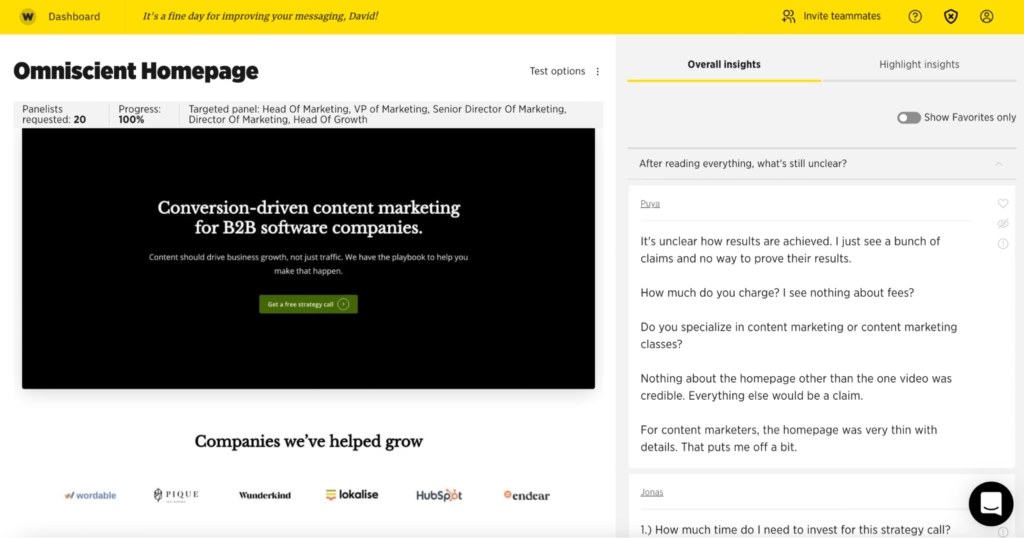
And here’s a test we recently conducted on a new thought leadership services page:
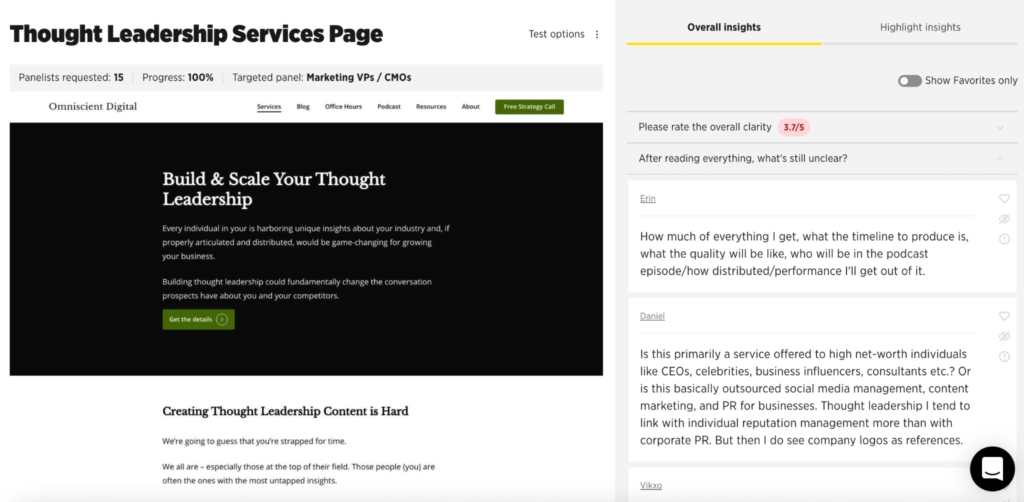
The cool part is that we were able to select our target audience – marketing VPs and CMOs – and Wynter does all the work recruiting them and setting up the panels.
You’ll notice they mix quantitative attitudinal insights (i.e. the “clarity score”) with qualitative open-ended feedback. Personally, I get the most value from the qualitative stuff.
These insights have helped us rebuild our landing pages from the ground up, resonating and differentiating from the many competitors in our space.
2. Message Clarity Testing Tools – FiveSecondTest
A study done as early as 2015 found a lack of message clarity as one of the core reasons why visitors opt to leave a website.
Makes sense. “Clarity trumps persuasion” is the classic motif.
From a common sense perspective, if visitors can’t comprehend what you’re saying, they can’t be persuaded by it.
You, the marketer, are often too close to the problem, though. It all makes sense to you because you work at this company and grok all of the messaging. Possibly not true for your landing page visitors.
Enter: message clarity testing tools.
The most popular of these tools is probably FiveSecondTest. As the name suggests, FiveSecondTest will display your page contents to test subjects for only five seconds and then ask them to describe what they remember.
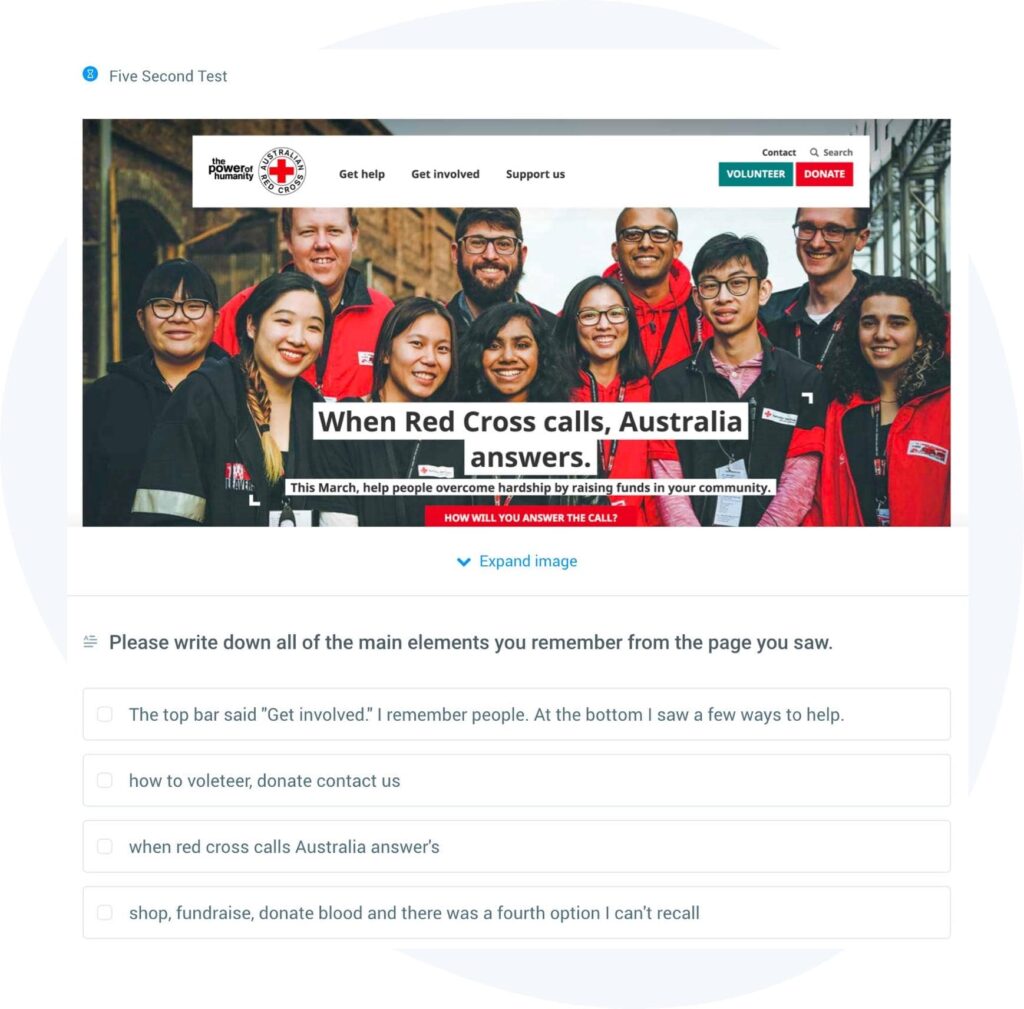
If you don’t want to pay for a tool, you can also just ask customers or friends who are in your target market to review the page and point out confusing copy. There’s likely more confusing copy than you would have thought.
Honestly, if you’re able to be objective, you can probably look at your own landing page and consider the clarity. Imagine you were a marketer at GatherContent and looking to optimize this branded landing page:
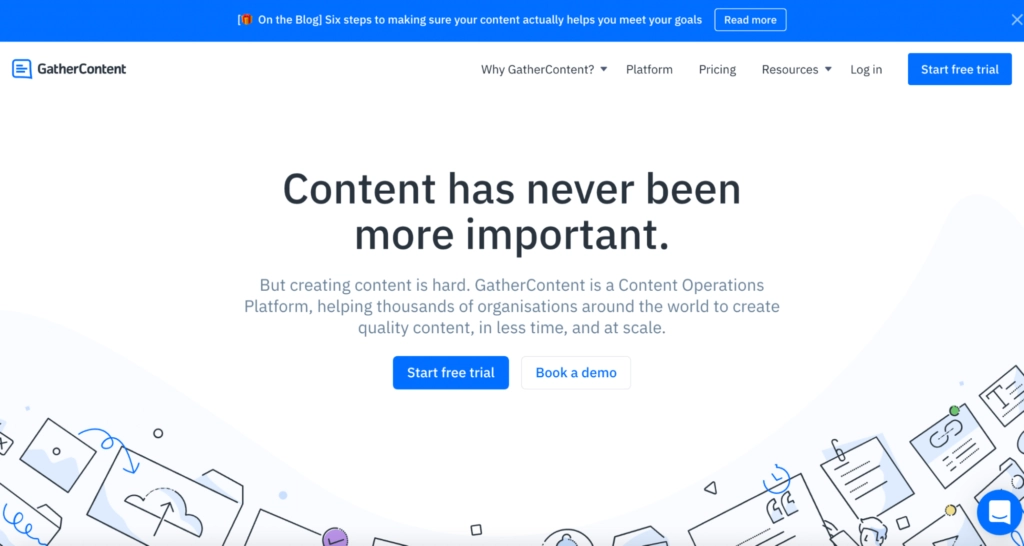
Knowing that the audience is people who are searching for your brand name, you can ask yourself, “does this message immediately make sense?”
This is just my opinion, but I’d say it doesn’t do a perfect job illustrating either the benefits or the pain point solved with the platform. The subheadline gets a little more specific with “GatherContent is a content operations platform, helping….”
But if I were optimizing this page, I’d test clearer messaging. Answer, “what does it do for me?”
3. Heatmap Tools – Fullstory, Hotjar
Third on our list of message testing assets are heatmap tools – which, unlike the other two preceding categories, are not entirely qualitative.
Their job is to track visitor activity on your landing page and then prepare page interaction insights in the form of a graphical snapshot.

Image Source
This should give you a good idea of what the audience is clicking on, how far they’re scrolling, where they are spending most of their time, etc.
Fullstory and Hotjar are two of the most popular tools in this category. However, most qualitative data tools now have heatmap functionality. These may not be able to tell you why users aren’t resonating with your copy, but they will certainly give you a map to identify the biggest opportunity areas on a page.
Heatmaps are an absolutely classic way to do conversion research for landing pages.
These tools typically also have session replays, which let you watch anonymous visitors interact with your website. This is similar to user testing, but you get a much greater sample (although you can’t control the panel as well).
4. Online Poll Tools – Qualaroo, Hotjar
When in doubt, just ask your visitors what is confusing or what information they’d like to see.
Heatmapping is great for visually representing user behavior. But online polls can help you quantify pain points (based on the sheer volume of similar responses) as well as something particularly unique about this method: they can give you Voice of Customer data that you can just copy and paste into your copy.
Say, for instance, you launch a poll on a landing page that asks, “what information were you looking for but couldn’t find?”
Answers could vary. Let’s say you’re running a translation software company, bidding on keywords like “translation software”
Upon clicking the ad for Smartling, I see that I’m directed to the homepage, and there’s a small chat icon that opens up.
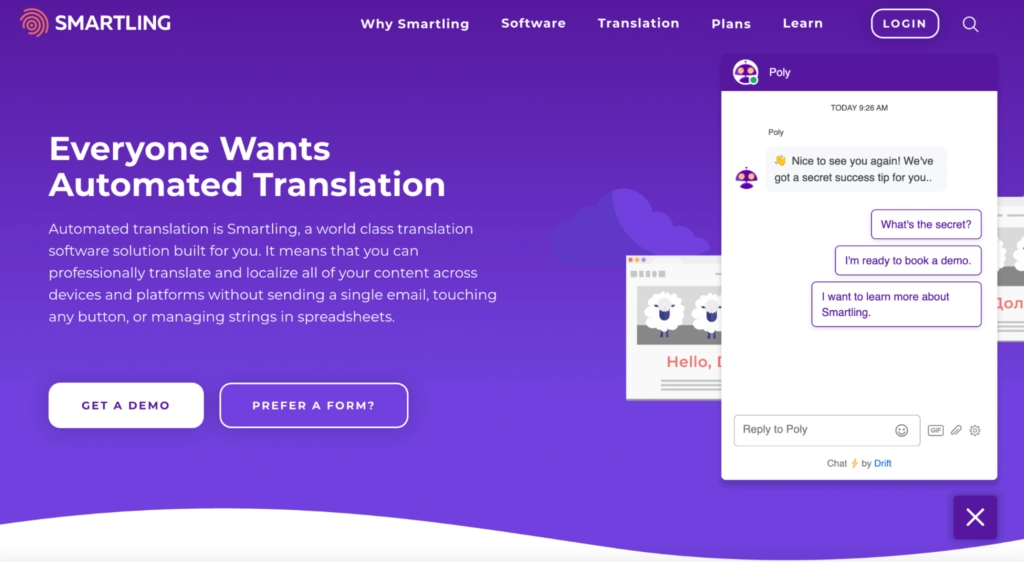
This is a great conversion tactic, but it could also be used for conversion research.
Again, let’s imagine they prompted me with a question about what information I was looking for.
Perhaps, I (and many others) mentioned that I couldn’t find any information about what integrations they have. Do they integrate with WordPress? HubSpot? What CMS tools can I connect this to?
Get enough of those responses, and you know two things:
- People really care about integrations. This is an anxiety and relevance point for them.
- Which specific integrations they mention lets you know which ones to mention on your page.
Bam – this gives you both quantitative indicators as to what people are looking for as well as specific ideas to add to your messaging.
As I mentioned, you can use chatbot and live chat tools for this (like Intercom and Drift). But there are also powerful polling tools like HotJar and Qualaroo that you can use.
One big benefit of running these is that you get feedback from anonymous visitors who haven’t purchased yet. This means you can typically:
- Collect a greater sample of responses
- Collect from those not biased by purchase (customers can overlook hesitations and information gaps)
- Get more honest responses
How To Run A Message Test
Alright, so now you’ve got a bunch of tools and methodologies.
What do you actually do now with these?
Here’s my process:
- Step one: quantify which landing pages are underperforming. You can find this in Google Ads, Google Analytics, or whichever landing page tool you’re using. Look for pages with higher than average bounce rates, or better yet, lower than average conversion rates. Prioritize the highest traffic pages because the impact is higher.
- Implement “passive data collection” first. These are the heatmap and polling tools. I say “passive” because, unlike user testing and message testing, you don’t have to actively conduct a test for each response. You just install a javascript snippet and let the responses and data roll in.
- Conduct a Wynter test (or if you’re on a budget, a Five Second Test) on your highest opportunity page or pages.
- Analyze the data from your polls and heatmaps and combine these insights with your Wynter test.
- From these data sources, begin building a backlog of insights and learnings. These insights then get translated into action items or experiment ideas.
- Prioritize this backlog based on the PXL model. This will help you take dozens to hundreds of ideas and prioritize the most likely to succeed.
When I’m analyzing the insights, I like to tag them using a conversion optimization methodology like the LIFT model. You don’t have to do this, but I find that it is useful in organizing what will inevitably be hundreds of insights from your research.
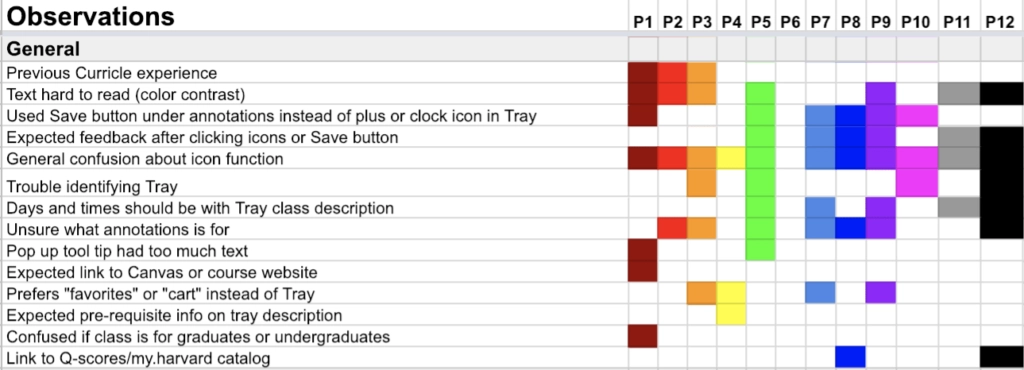
Voila – you’re quantifying the impact of your copywriting and pulling proactive ideas to improve it.
Conclusion
There’s no universal process for messaging testing.
There are tools and guidelines, however. In essence, you need to:
- Benchmark your current performance
- Identify improvement areas
- Identify your key business questions you want to explore with research
- Choose the approach research methodologies and conduct them
- Organize your insights into a spreadsheet
- Turn insights into actions and prioritize them
- Repeat
It’s a never-ending process. The copy that resonates today might not work tomorrow, so never stop optimizing, growing, and improving.
Related Content
___

Alex Birkett is a co-founder at Omniscient Digital, a premium content marketing agency. He lives in Austin, Texas, with his dog Biscuit, and he loves to ski, scuba dive, and write about growth.
guest






